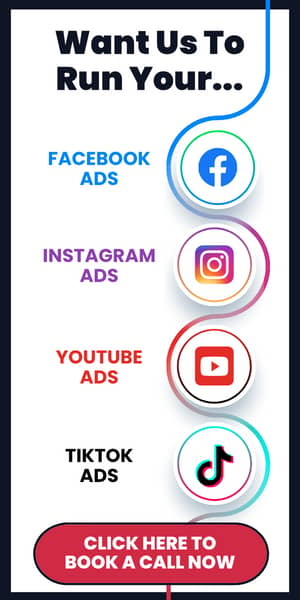Do you shell out thousands of dollars each month on Google advertising, only to wonder if your money is being put to good use? It’s frustrating to see your hard-earned cash evaporate into thin air without seeing the returns you expect.
You know your business is capable of scaling, but your current ad optimization strategy seems to be draining your resources rather than fueling your growth.
And imagine the impact of those wasted dollars on your bottom line and the opportunities you’re missing out on…
- The potential clients who could benefit from your coaching or consulting.
- The eager audience waiting to be inspired by your speaking engagements.
- The seekers that are hungry for the expertise you offer.
All these prospects are just a click away, but a flawed ad strategy is keeping them at bay.
It’s time to implement a laser-focused Google Ad Optimization strategy so that you can:
- Leverage data-driven insights
- Hone in on the right keywords
- Craft compelling ad copy
This can transform your advertising campaigns into efficient lead generators. When your ads reach the right people at the right time, they can convert casual browsers into high-value clients and build substantial revenue. All you need is the right Google Ad Optimization strategy.
If you’re ready to transform your advertising investments into powerful revenue generators, unlock your true growth potential, and continue to dominate your industry, then it’s time to adopt a data-driven, meticulously crafted Google Ad Optimization strategy.
How Do Google Ads Work?
Google Ads can be an incredibly powerful tool for bringing in clients for businesses within the coaching, consulting, speaking, and expert niches that match your customer avatar’s profile.
Here’s how Google Ads work to achieve this:
Keyword Targeting: Google Ads operates on a keyword targeting system. When users search for specific keywords or phrases related to your niche, your ads have the potential to appear at the top of the search results page.
This ensures that your ads are displayed to individuals actively seeking information, services, or products related to what you offer, which can help optimize your search ads.
Ad Placement: Your ads can appear on various platforms within the Google network, including Google’s search engine result pages (SERPs), Google Display Network (GDN) websites, YouTube, and even in mobile apps, allowing you to target your potential clients across different online spaces.
Ad Formats: Google Ads offers various ad formats, including text ads, display ads, video ads, and shopping ads.
Depending on your specific goals and audience preferences, you can choose the format that best suits your message and content.
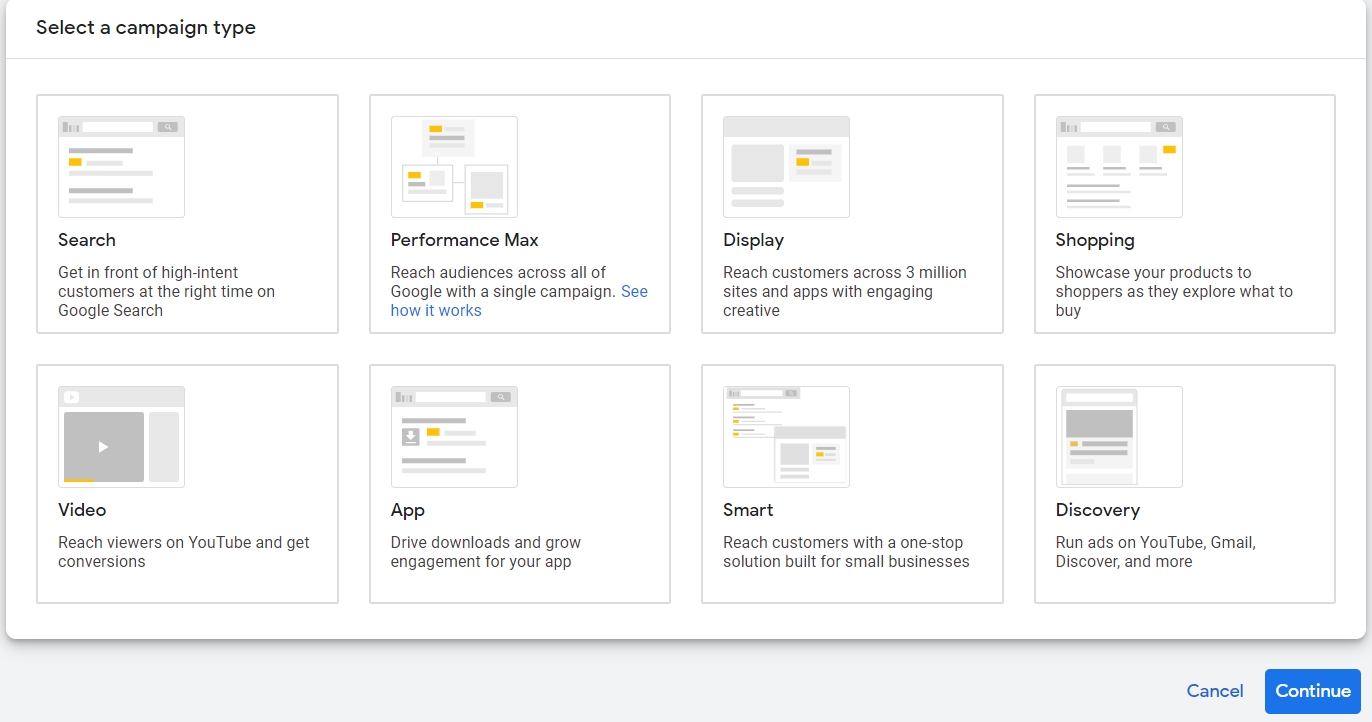
Audience Targeting: To ensure your ads are seen by the right people, you can set specific audience targeting parameters, including:
- Location
- Demographics
- Interests
- Online behavior
- And more
This precision targeting helps you reach individuals who are most likely to resonate with your services.
Ad Rank and Bidding: Google determines the placement of your ads based on factors such as the relevance of your ad to the search query (Quality Score), your bid amount, and the expected impact of ad extensions.
Bidding strategies allow you to control how much you’re willing to pay for each click (CPC) or for specific actions (e.g., conversions) to ensure you’re getting the most value from your budget.

Conversion Tracking: Setting up conversion tracking allows you to measure the effectiveness of your Google Ads campaigns. You can track actions that align with your goals, such as sign-ups, purchases, or inquiries. This data helps you assess which campaigns are driving the most valuable results and optimize accordingly.
Remarketing: Remarketing allows you to target users who have previously visited your website but didn’t convert. By displaying tailored ads to these users across the Google Display Network and other platforms, you can remind them of your offerings and encourage them to return.
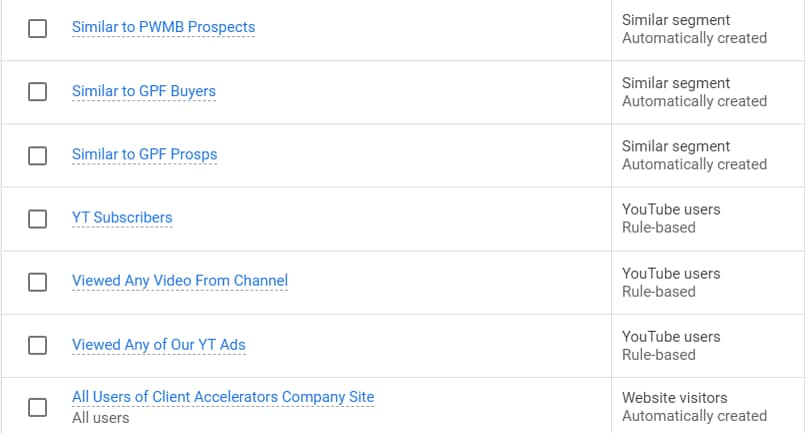
Google Ads works by strategically placing your ads in front of potential clients who are actively searching for the services or products you offer. Through precise targeting, compelling ad content, and data-driven optimization, Google Ads can drive high-quality traffic to your online sales funnel, helping you connect with individuals who are more likely to convert into clients.
How to Create a Google Ad That’s Worth Your Budget
To create a Google Ad that maximizes your budget, follow these steps:
Step 1: Define Clear Objectives
Before you start crafting your ad, define your objectives. Are you aiming for lead generation, product sales, event sign-ups, or something else?
Be specific about your goals and the desired outcomes.
Then you’ll need to set up your Google tracking in your funnel to reflect those outcomes when they occur, which builds a model for Google to understand what you want to accomplish with your ads.
At the end of the day, Google wants you to win because the more money you make, the more money you want to spend with them. To make that happen, Google needs to know very specific information about how its campaigns are performing for you.
This is why it’s so critical to get your tracking set up correctly on the ad platform and to also feed Google more accurate data from third-party tracking sources.
Our favorite is Hyros, and we use it to send back the sales information for each of our campaigns including when a sale occurs and how much it was for. The reason this is important is because when you have long sales cycles where it takes upwards of 2 weeks to a month to close a deal, that customer is going to have multiple touch points with your business.
Not only that but with iOS 14 updates, privacy updates on Google, ad blockers, clearing cookies, and more, you’ll be losing sight of customers and where they initially came from.
Hyros works by storing multiple pieces of information about your customers such as their IP Address, session ID, email address, phone number, and more.
When it collects this information upon the initial interaction, it’s able to easily identify the user at the next interaction where, let’s say, they are using their phone rather than their laptop.
Step 2: Keyword Research and Selection
Perform thorough keyword research to identify the search terms your target audience is using.
Focus on high-intent keywords relevant to your niche. Use tools like Google Keyword Planner and other keyword research tools to identify the most effective keywords.
Keyword research is a very important piece of running any type of ad on Google… even for running YouTube campaigns.
Unless you plan on making all of your money by targeting ‘in-market’ audiences, life events, or demographics, you’ll definitely need to add some keyword research into your forte.
To create highly profitable custom intent audiences, you’ll need to identify the keywords that are very high intent and relevant to your offer.
Here’s an example of a highly profitable keyword we’ve put together for an 8-figure business opportunity offer. In this first campaign, we are targeting the keyword ‘Entrepreneur’.
Now anyone searching for different variations of the word entrepreneur is highly likely to be involved in business, making these people prime prospects for a business opportunity offer.
In this next campaign, we are going after custom affinity audiences built using military and veteran websites.
You might be asking yourself, military and veteran’s websites for a business opportunity offer, but something isn’t adding up here…
Well in this specific case, the entire brand story is built around a military veteran who wanted to figure out how to make more money.
We found that not only does this specific niche love the offer, but it has been a very lucrative customer avatar to cater to.

Step 3: Compelling Ad Copy
Craft compelling ad copy that resonates with your audience’s pain points, desires, and aspirations. Address how your coaching, consulting, speaking, or expert services can provide solutions and add value to their lives.
Highlight the challenges your potential clients might be facing. Address their pain points, so they feel understood.
Here’s an example of our client, Ryan Cole, who helps people with their thyroid problems.
The pain points his target market is experiencing include pain, swelling, hypertension, back pain, and a sleuth of other health issues.
In order to agitate these issues, we directly call them out in our headlines, hooks, and ad copy.
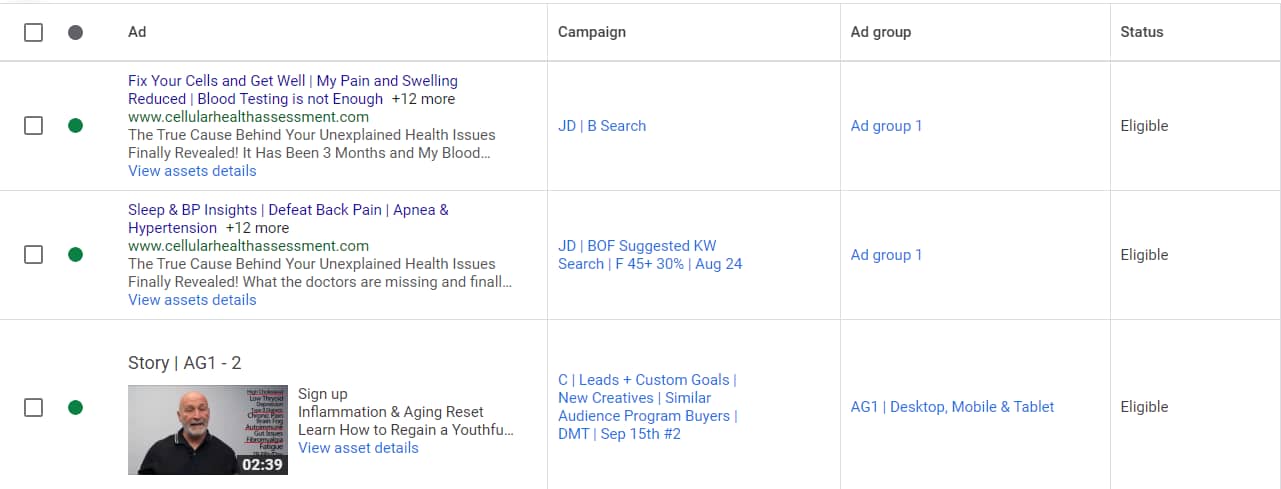
Then offer the solution: Offer your unique value proposition and explain how your services can solve their problems and meet their needs.
In order to craft your unique value proposition for your offer you can use the following framework.
I help (insert your target market) to (insert the result you achieve) through using our (insert unique mechanism).
Here is an example:
I help people suffering from back pain, swelling, and inflammation to reset their aging and regain a youthful appearance by using my 5-phase exposure therapy program.
This blanket statement will serve as a guide for your copywriters to craft your headlines, captions, body text, etc. as it contains your target audience, your solution, and how you get your customers from point A to point Z.
Conclude with a call to action: Use a strong and clear call to action that guides users towards the desired action, such as clicking on the ad to learn more or signing up for your offer.
A call to action might be the most important part of your advertisement. Without it, how will people know to take action and end up converting?
At the end of the day, telling people to sign up, schedule now, learn more, or book an appointment is going to do much better than not asking them to do anything.
But how do you craft a truly compelling call to action that moves your audience emotionally and makes them feel truly called to what it is you have to offer?
Your call to action is simply the climax of the build-up process your copy is doing. A great CTA is placed meticulously when the user has been moved emotionally and where they are most likely to take action.
Let’s take a look at an example:
In this video, Dr. Cole hooks viewers in by calling out their specific pain points.
Then he dives into educating his audience on the real reason they’re experiencing them and what his unique solution is.
After he tells them what their life could look like after implementing his solution—where they feel a sense of reprieve—he then hits them with the call to action.
This is a great example of the call to action being the climactic moment after the rollercoaster of emotions he brought his audience through.
Step 4: Landing Page Optimization
Ensure your ad leads users to a dedicated landing page that is aligned with the ad’s message.
The landing page should reiterate the value proposition of the ad.
You’re taking your audience through a personalized experience and a step-by-step system designed to get them to purchase your product.
The experience should be extremely smooth and the information should be congruent with what they just heard in your advertisement. If not, you’re going to lose them and your opt-in rate will be below average.
So how do you ensure that your landing page matches your advertisement?
We do a thorough inspection of our client’s funnels, websites, social media pages, and more where we take notes on the specific language that is being used.
Once that thorough inspection is completed, we then begin working on the copywriting which allows us to write within our templates and frameworks using the client’s brand voice.
Auditing your content for synchronicity at each point in your funnel will ensure that nothing falls through the cracks and give you the ability to spot any errors you may need to address.
Clearly present your free lead magnet, webinar, or video sales letter:
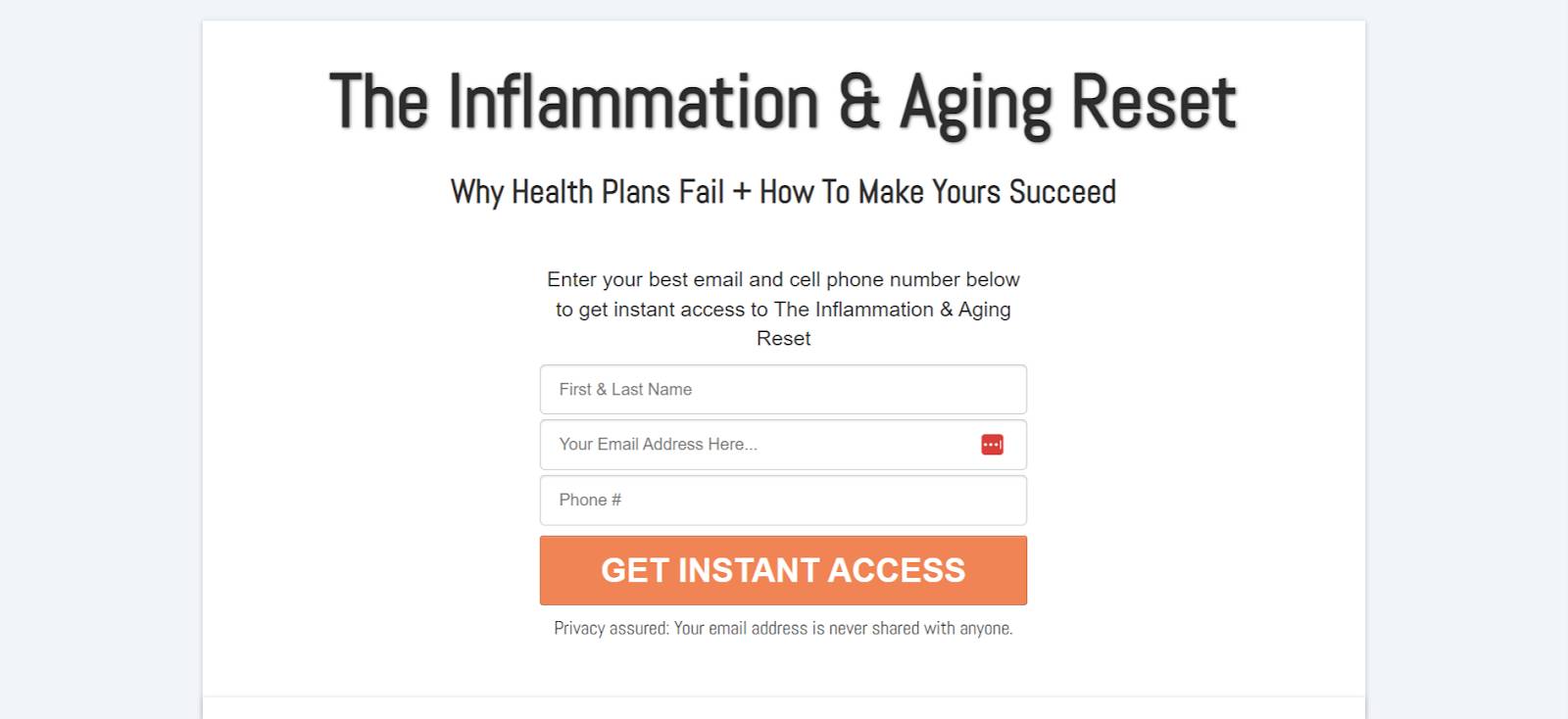
Include a prominent call to action for users to convert (e.g., sign up, buy, contact).
For any webinar, lead magnet, or VSL training a great CTA to use for your button is ‘Get Instant Access’.
This cuts through the objection running through your audience’s head of when they will actually get access to the resource, making them more likely to take action to achieve the reward.
It’s important to have a clean and user-friendly design. There’s no need to overcomplicate your opt-in page with a bunch of different web elements.
In fact, we see that the simplest opt-in pages perform the best and create way less friction at the beginning of funnels.
Don’t believe us? Let’s take a look at the numbers:
Amped Local’s Landing Page: Opt-in Rate – 21.35%
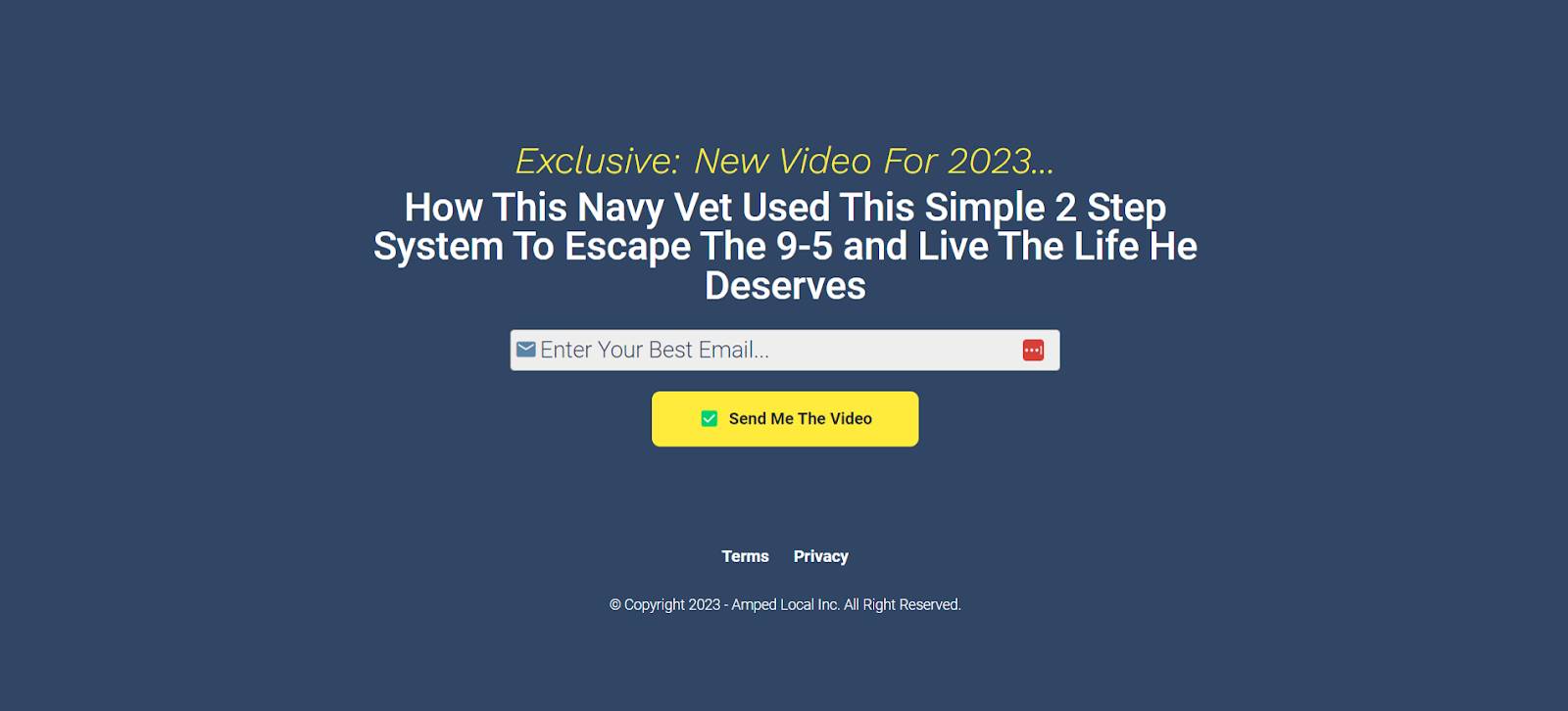
Lifelong Learning’s Landing Page: Opt-in Rate – 28.23%

Double-check to make sure your page is loading quickly and is mobile-responsive.
The surefire way to lose the confidence of your users is to make them wait more than 2 seconds to see your content.
I know… we’re so privileged these days.
But the truth is, your competitor’s landing page loads in 0.5s. So why wouldn’t they just look at their stuff instead of yours?
Step 5: Tracking and Conversion Measurement
Implement conversion tracking to measure the effectiveness of your ad campaign.
Set up tracking for key actions such as sign-ups, purchases, or inquiries. This data will help you evaluate the ROI of your ads and optimize for better results.
Here is an example of funnel and conversion tracking flow:
- Opt-In Page: Lander View
- Webinar / VSL: Lead
- Scheduler Page: Scheduler View
- Application Page: Booked Call
- Thank You Page: Submitted Application
Once you get all your conversions set up at each point in your funnel, you’ll need to use a third-party tracking system, like Hyros, to get 95% accurate reporting on your conversions including sales. Check out this article to learn more about how we use Hyros to get the most accurate tracking—and how we use it to optimize lead quality.
Step 6: A/B Testing and Optimization
Continuously improve your ad’s performance through A/B testing:
- Test different headlines, ad copy, and calls to action.
- Experiment with various ad extensions to see which ones drive the best results.
- Monitor your campaign’s performance metrics, such as click-through rate (CTR) and conversion rate.
- Use the insights gained to refine your ads, targeting, and landing pages for better conversions.
Once you find winning variations, try to beat the control with a new hook, a more compelling call to action, or a more meaningful story.
How to Optimize Google Ads to Perfection in 6 Steps
Let’s take a look at how to optimize Google Ads effectively using these 6 steps:
1. Laser-Focused Audience Targeting
Utilize advanced audience targeting options to reach individuals who closely match your customer avatar’s profile.
Refine demographics, interests, and behaviors to ensure your ads are shown to the most relevant potential clients.
Come up with 5-10 new custom affinity, custom intent, custom website, or demographics each month to discover new winning audiences to add to your portfolio.
Continuing to find new winning audiences and honing in on the demographics will ensure that your targeting moving forward will be efficient and lead to saving much more money with your ad spend.
2. Keyword Optimization
Continuously monitor and refine your keyword list. Focus on high-intent, relevant keywords that align with your offerings.
Use these keywords in your Search campaigns as well as for building up your custom audiences for video campaigns.

You can find out what keyword variations you’re ranking for by going into the Search Term section of your campaigns.

Add irrelevant keywords into your negative keyword list so you no longer waste any ad spend on them.

3. Landing Page Optimization
Ensure your landing pages are fully optimized for conversions. The landing page experience should match the promise of your ad.
Implement clear and prominent calls to action, minimize distractions, and improve load times.
Do a thorough inspection of your website, social media platforms, and your funnel to identify specific keywords, key topics, and the verbiage used to talk about them.
There should be consistent themes across the board, and you can incorporate the specific language you used into your sales funnel and advertisements to make them more congruent.
4. Conversion Tracking and Measurement
Set up accurate conversion tracking to measure the actual impact of your ads on lead generation, sales, or other key actions.
Analyze conversion data to identify which campaigns, keywords, and ad variations are driving the best results.
Shift your budget away from the losing campaigns and put them into your winners to optimize your spending.
If you want to get the best bang for your buck with your ads, then we also highly recommend setting up Hyros to track your advertisement performance.
5. Bid Management:
Adjust your bidding strategies based on the value of different keywords and the likelihood of conversion.
Use automated bidding options like Target CPA (Cost Per Action) to align your bidding with your desired cost-per-action range.
This will push Google’s algorithm to get cheaper conversions for your account.

6. Ad Schedule Optimization:
Analyze the times and days when your ads perform the best.

Adjust your ad schedule to focus your budget during peak performance periods.
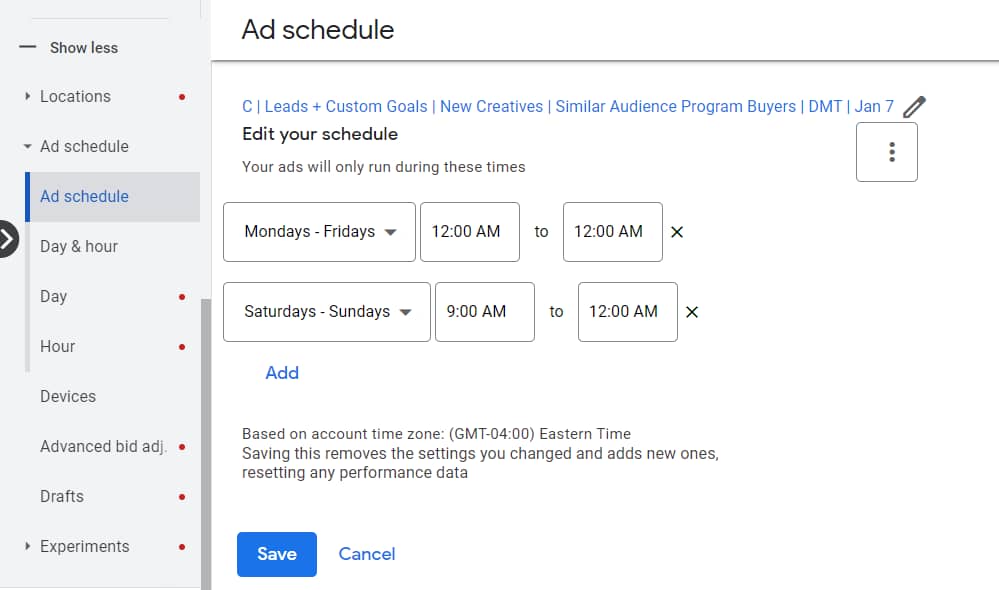
Here’s your Google Optimization Checklist:
Biweekly Actions: Fine-Tuning For Optimal Performance
Keyword Monitoring and Refinement:
- Review search terms triggering your ads.
- Adjust keyword bids for better-performing keywords.
Ad Copy Testing and Optimization:
- Test new ad copy variations.
- Identify which ad copy resonates best with your audience.
Conversion Data Analysis:
- Analyze recent conversion data.
- Identify trends and adjust campaigns accordingly.
Monthly Actions: Refining Your Campaign Strategy
Audience Refinement:
- Analyze audience demographics and behaviors.
- Refine targeting based on performance and insights.
Landing Page Performance:
- Assess landing page performance metrics.
- Make necessary updates to improve conversions.
Bid Strategy Adjustment:
- Evaluate bid strategies and ROAS performance.
- Adjust bids to align with the desired ROAS range.
Quarterly Actions: Holistic Campaign Assessment
Comprehensive Campaign Review:
- Conduct a holistic review of campaign performance.
- Identify overall strengths, weaknesses, and opportunities.
Keyword Expansion and Optimization:
- Research and add new relevant keywords.
- Remove underperforming keywords to optimize the budget.
Ad Copy Audit and Improvement:
- Review ad copy across campaigns.
- Identify areas for improvement and adjust accordingly.
Conversion Funnel Analysis:
- Examine the entire conversion journey.
- Identify any bottlenecks and optimize user flow.
Budget Reallocation:
- Analyze budget distribution across campaigns.
- Adjust budgets based on campaign performance and goals.
Optimize & Scale Your Google Ads Today
Mastering Google Ads optimization is all about strategy.
Start by precisely targeting your audience, and constantly refining demographics, interests, and behaviors for relevance. Optimize keywords and bidding to keep costs in check; make sure your landing pages align with your ad promises and set up robust conversion tracking for maximum impact.
This is how you stay ahead of the game with efficient AdWords optimization.
Regularly scheduled actions and quarterly assessments will keep your campaigns on the path to improvement, higher ROI, and overall success.
Want to learn more about how to optimize your Google ads to scale your business? Book a call now to get started.


